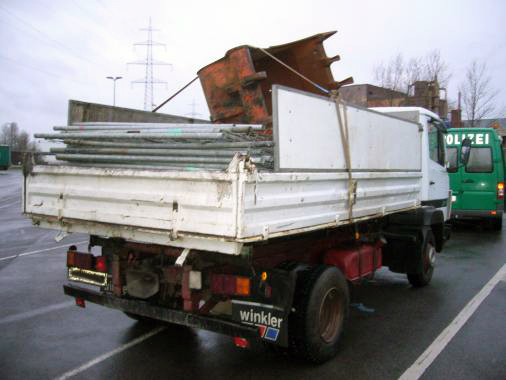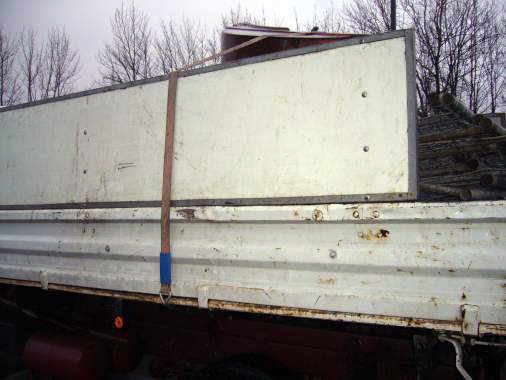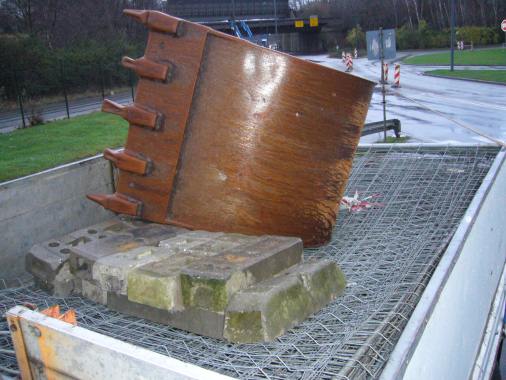| Photo of the month – February 2007 | [German version] |
A romantic interlude for an excavator shovel
The title alone makes it pretty clear that your load-securing columnist is having difficulty taking a load of this type seriously. The question begs to be asked whether the person responsible for this transport and its load has any clue whatsoever about physical relationships.
To place this heavy excavator shovel on top of the rather soft and yielding barriers is a sign of very considerable ignorance. After such a transport of delight, some of the barriers will undoubtedly be of no use to anyone. What a pity!!

Figure 1
If this transport were not meant seriously, the attempt at load securing would provide an entertaining counter-example for any training course in load securing. But it is still worth a second look. Looking at this attempt at securing a load from the point of view of somebody who, as part of the KLSK (Königsberg Regional Load Securing Committee), is dedicated to improving load securing on our roads, it’s hard to keep one’s composure.
But let’s look at this calmly and objectively:
| An attempt was made to use tie-down lashings on a flexible surface. This means that there wasn’t the remotest chance of achieving even the very slight securing effect of the lashing (in this example), as the flexible surface on which the load was resting always sagged when any degree of pretensioning had been built up. After a few meters at best, the barriers would have given way. |

Figure 2
| The belts were tensioned over the very flexible side walls which 1.) made it impossible to establish any degree of pretensioning and 2.) resulted in a 45° angle for the lashing, which reduced the securing effect of the tie down (which was already negligible) by around 30 %. |
|
| The friction issues are also quite remarkable! A tie-down lashing stands and falls on friction. The greater the friction, the greater the securing effect of the tie-down. At this point, an expert with that sort of mind will be asking what level of friction sagging wire mesh like this might have and, after chewing his pencil for a while guesses at around 5-10 % (µ=0.1 or 0.05). Which isn’t exactly very much. The fact that a tie-down lashing was nevertheless used for securing is, to put it mildly, thoughtless in the extreme. And it is of no help as far as the load securing situation is concerned that front of the excavator shovel is partially resting on the concrete stands for the barriers. Why these concrete stands are not under the barriers, which would be a more suitable place for them, remains one of the many mysteries. |

Figure 3
| And finally, we should have a look at the tight-fit securing, that would have been entirely appropriate for a load of such a weight. But we look in vain. It is not just that the excavator shovel was not loaded tightly: even the barriers were not loaded with a tight fit. |
Which leaves us with the question of just how to secure a shovel like this securely. To start with, under no circumstances on this vehicle with this type of load already in place!
A heavy load of this type should wherever possible be loaded directly onto the loading area of the vehicle. If it is possible, after taking account of the distribution of the load, the shovel should be loaded hard up against the end wall. The use of friction enhancing mats achieves a good coefficient of friction. A tie-down lashing as a minimum load securing measure damps vibrations and oscillations and a loop lashing to the back holds the shovel securely. Of course, there are still people who believe that a coefficient of friction µ of 0.5 or 0.6 will surely be enough. Okay, to meet the standards, it may be enough, but we are speaking of load securing here, and it is well worth having something in hand. It is far better to be on the safe side. If it is not possible to achieve a tight fit to the front, then friction-enhancing mats and loop lashings are the materials of choice to deal with a load securing problem like this one.
This example is well on the way to winning the Golden Raspberry in the 2007 load securing awards.
Back to beginning
